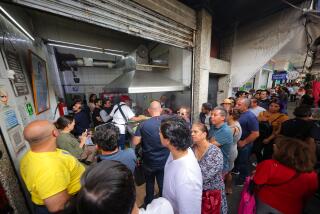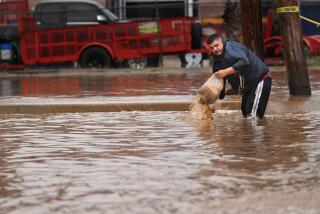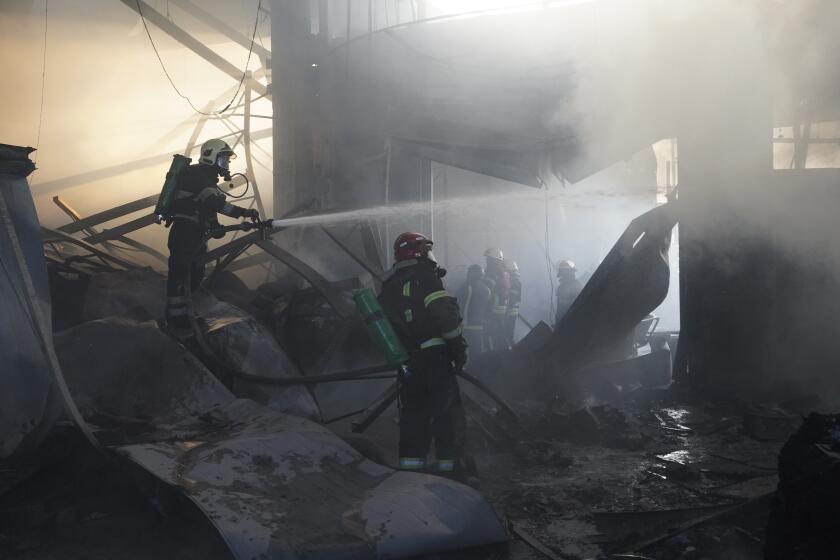A ‘Tin Can’ Keeps Watch on N. Korea
It’s nighttime as the destroyer churns up a phosphorescent wake in the Pacific. The dimmed lights of electronic equipment cast a soft green glow over the bridge, while red lamps add the eerie look of a darkroom.
Resuming his starboard watch, Ensign Curtis Peschel ducks out to the lookout posts. It’s pitch black save for the Milky Way, which stretches across the horizon, and a crescent moon hanging low in the sky.
For the next four hours, Peschel, the John S. McCain’s communications officer, will be driving the $1-billion ship. He has been in the Navy less than two years. The McCain -- named after the grandfather and father of Republican Sen. John McCain of Arizona -- is his first ship.
“We get a lot more hands-on experience out here,” said Peschel, 25, from Mercer Island, Wash.
The McCain, and the 7th Fleet to which it belongs, have a unique place in the Navy.
Home for this state-of-the-art destroyer isn’t the United States, it’s Yokosuka, Japan. The 7th fleet, the Navy’s largest, is the only one that is “forward deployed,” meaning that when something happens in the region, it is often the first to respond.
It’s an increasingly tense assignment:
* High on the fleet’s list of concerns is North Korea, which has a fledgling nuclear weapons program. It has been improving its long-range missile capabilities and periodically test-firing ground-to-ship missiles into the Japan Sea, most recently in May.
* China, which is bolstering its navy, last year touched off a row with Tokyo when one of its submarines surfaced off the southern island of Okinawa. This summer, it deployed warships to an oil-rich area that Japan also claims, causing another diplomatic dispute. Taiwan, meanwhile, reportedly plans to upgrade its submarine-based missiles, which would raise tensions with Beijing.
* Though no longer Washington’s Cold War rival, Russia has major naval installations along its Pacific coast. Also, piracy in Malacca Strait between Indonesia and the Southeast Asian mainland is a constant threat to commercial shipping.
“We’re in an important part of the world with a lot of things going on,” Commodore Bob Girrier, commander of Destroyer Squadron 15, said. “Destroyers bring a great many capabilities into play.”
In a typical year, the McCain will be at sea more than six months, longer than most ships based in the U.S. The 7th Fleet’s area of responsibility covers 52 million square miles of the Indian and Pacific oceans.
When called upon, the ships go even farther. Brimming with weapons -- including Harpoon anti-ship missiles and long-range Tomahawks -- and equipped with Aegis radar, the McCain launched strike missions in the Persian Gulf during the U.S.-led invasion of Iraq.
“Because we’re small, it’s easier to send us out,” said the McCain’s commanding officer, Capt. William Wagner. “We have to get down and dirty.”
*
Lt. j.g. Marissa Pernisi, who is from Camden, N.Y., got into the Navy because she wanted to see the world. But she didn’t have the frigid Japan Sea in the dead of winter in mind.
Along with three other 7th Fleet destroyers, the McCain has been assigned to a North Korea watch announced last year at the height of concerns over Pyongyang’s nuclear weapons program.
“We were the third ship on station,” said Pernisi, who is the McCain’s training officer and, when needed, its public affairs officer. “The Japan Sea in the winter is not the place to be. It was cold. Even the Russians won’t go out. Or the Japanese. We all stocked up on long johns and turtlenecks.”
The mission is part of a multibillion-dollar shield to protect the United States from ballistic missiles. In 1998, Tokyo was shocked when Pyongyang test-fired a multi-stage missile over Japan’s main island. It landed in the Pacific.
Pernisi, 25, said the McCain was on the North Korea watch for about two months, but because of the weather and other factors the ship had not remained on station the whole time.
“We had a little box we were in, going back and forth,” she said. “It’s not real exciting. But it’s a mission that is important to the Navy, and important to the military, and we’re here to support that just in case something ever happens.”
Much of the mission is classified, but the 7th Fleet destroyers provide long-range search and tracking capabilities. Eventually, data gleaned by the ships could be transmitted to Ft. Greely in Alaska and Vandenberg Air Force Base, from where, if necessary, interceptor missiles would be launched.
*
If aircraft carriers, with their crews of several thousand, are floating cities, destroyers are more like one-stoplight towns. Compared with the 5,000 or so sailors and aviators aboard the Kitty Hawk, the carrier assigned to the 7th Fleet, the McCain has a crew of about 350.
It has the usual conveniences of today’s Navy. There’s a post office. There are places to work out. Back by “McCain Field,” the ship’s helipad, there are candy and soda machines. There are nacho nights and movie nights and, every now and then, a “Steel Beach” barbecue on the deck.
But destroyers have the nickname “tin cans” for a good reason.
The ship’s store can only hold two customers at a time. About the only place where sailors’ have any privacy is their beds, or racks. Not big enough to sit up in, the beds are stacked several deep in the lower decks.
For many sailors, that is part of the destroyer’s appeal.
“It’s a tight family,” Petty Officer Vernado Spear, 21, said as he watched the sci-fi movie “Biohazard” on a big screen TV on the mess deck with about a dozen other sailors. “It’s only so big, so you know everybody,” said the native of Concord, Ga. “That’s one of the good points.”
On this particular night, however, there wasn’t much socializing going on.
The crew had just completed a week of anti-submarine warfare maneuvers with the Japanese. They had been drilling hard, and keeping long hours.
“People are tired,” said Spear, whose father recently retired as master chief petty officer on the Kitty Hawk. “Usually after dinner people start disappearing to their racks. Everybody wants to relax, unwind, catch up on some sleep.”
Even when there are no maneuvers, sailors keep long hours.
Spear said his average day started at 6 a.m. After breakfast, he has roll call at 7:30, does some cleaning, and starts his administrative job at 11. He has lunch, then at 12:30 is back at the office, where he works until 6. After that, he has dinner and is free by 6:30.
“I work out, play video games, watch TV, check the Internet,” he said. “I usually go to bed around 11. But you’re never really off. When you’re at sea, it’s a 24-hour day.”
More to Read
Start your day right
Sign up for Essential California for news, features and recommendations from the L.A. Times and beyond in your inbox six days a week.
You may occasionally receive promotional content from the Los Angeles Times.





